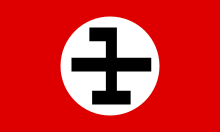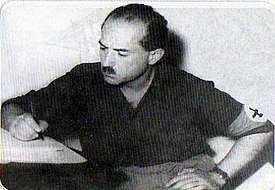SUMKA
The National Socialist Workers Party of Iran[1] (Persian: حزب سوسیالیست ملی کارگران ایران, romanized: Ḥezb-e Sosīālīst-e Mellī-e Kārgarān-e Īrān), better known by its abbreviation SUMKA (Persian: سومکا), was a neo-Nazi[3] party in Iran.
National Socialist Workers Party of Iran | |
|---|---|
| Abbreviation | SUMKA |
| Leader | Davud Monshizadeh |
| Spokesperson | Shapour Zandnia |
| Founded | April 1952[1] |
| Headquarters | "Black House", Khaneqah Street, Tehran[1] |
| Membership (1952) | 600[1] |
| Ideology | Iranian nationalism Fascism[1][2] Pan-Iranism[2] Anti-Arabism Neo-Nazism Anti-Semitism Anti-Communism[1] Anti-imperialism |
| Political position | Far-right[1] |
| Party flag | |
 | |
| |
Foundation

The party was formed in 1952 by Davud Monshizadeh[4] and had a minor support base in Iranian universities. Critics of the late Reza Pahlavi allege that he provided direct funding to the SUMKA at one point.[5]
Development
The SUMKA briefly attracted the support of young nationalists in Iran, including Dariush Homayoon, an early member who would later rise to prominence in the country.[5] Monshizadeh was supposedly somewhat of a Hitler worshipper, and was fond of the appearance and practices of the Nazi Party, such as their militarism and salute. On this basis, the SUMKA adopted the swastika and black shirt as part of their uniforms.[5][6]
They were firmly opposed to the rule of Mohammed Mossadegh during their brief period of influence, and the party worked alongside Fazlollah Zahedi in his opposition to Mossadegh. In 1953, they were part of a large group of Zahedi supporters who marched towards the palace of Mohammad Reza Pahlavi demanding the ousting of Mossadegh.[7] The party would become associated with street violence against the supporters of Mossadegh and the Tudeh Party.[1]
Shock troops
The party had an "assault group" (guruhe hamle) with an estimated size of 100 members that openly attacked members of the communist Tudeh Party of Iran and the Soviet Cultural Center and Hungarian Trade Office in Tehran. Colonel Fateh, a retired officer of the Imperial Iranian Air Force, was responsible for training the unit.[1]
Financial sources
Colonel Fateh was the official patron of the SUMKA.[1] After the 1953 Iranian coup d'état, the party received a monthly stipend of 2,500 Iranian rial from the police and other security authorities. In 1958, Monshizadeh received $7,000 from SAVAK to go to the United States.[1] The party was also possibly financed by foreign embassies based in Iran.[1] In April 1952, Iranian police reported that Monshizadeh was seeking to establish ties with the British embassy to get financial support. It was allegedly funded by the Central Intelligence Agency (CIA) through TPBEDAMN.[1]
Legacy
Advocates of Nazism continue to exist in Iran and are active mainly on the internet.[8] As of 2010, they are reported to be a small yet slowly increasing minority of Iranian youths.[9]
See also
References
- Rahnema, Ali. Behind the 1953 Coup in Iran: Thugs, Turncoats, Soldiers, and Spooks. Cambridge University Press. pp. 54–57. ISBN 1107076064.
- Bashiriyeh, Hossein. The State and Revolution in Iran (RLE Iran D). Taylor & Francis. p. 14. ISBN 9781136820892.
- Dabashi, Hamid (2015). Persophilia: Persian Culture on the Global Scene. Harvard University Press. p. 106. ISBN 9780674504691.
- Leonard Binder, Iran: Political Development in a Changing Society, University of California Press, 1962, p. 217
- Hussein Fardust, The Rise and Fall of the Pahlavi Dynasty: Memoirs of Former General Hussein, p. 62
- Homa Katouzian, Musaddiq and the Struggle for Power in Iran, I.B. Tauris, 1990, p. 89
- Mark J. Gasiorowski, 'The 1953 Coup D'etat in Iran', International Journal of Middle East Studies, Vol. 19, No. 3. (Aug., 1987), p. 270
- Maryam Sinaiee (24 November 2010), "Iranian ministry denies authorising neo-Nazi website", The National, retrieved 5 October 2017
- Lorena Galliot (18 November 2010), "Who's behind the 'Association of Iranian Nazis'", France 24, retrieved 5 October 2017